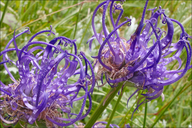|
|
click photo for larger file

Phyteuma orbiculare
Round-headed Rampion
|
Photographer: Dr. Amadej Trnkoczy
ID: 0000 0000 1015 0269 (2015-10-03)Copyright © 2015 Dr. Amadej Trnkoczy
|
|
INFORMATION PROVIDED WITH THE PHOTO
|
date of photo Jul 1, 2015
latitude 46.43833 longitude 13.63314
View on Google Maps.
location
Mt. Margart region, down-hill side bank or Mt. Mangart tool road before the last tunnel, East Julian Alps (Posočje, Slovenia)notes Slo.: glavičasti repuš - Habitat: stony grassland, road side, locally almost flat terrain, otherwise steep mountain slope, south aspect; full sun; calcareous, skeletal ground, exposed to direct rain, average precipitations ~ 3.000 mm/year, average temperature 1 - 3 deg C, elevation 1.800 m (5.900 feet), alpine phytogeographical region. - Substratum: sandy soil. - Comment: The genus Phyteuma is easy to recognize. Its species have tubular violet flowers with typical shape of eagle's claws. To distinguish between species is less easy. Phyteuma orbiculare has 5 to 15 flowers joined in a round cluster at the end of the stem and is somewhat similar to two other high mountain Phyteuma species - Phyteuma sieberii and Phyteuma scheuchzeri.. The best trait to distinguish among them is their involucre (o whorl of bracts subtending a flower cluster). Phyteuma scheuchzeri has entire (not toothed, with continuous margin), very long and narrow bracts (5 -25 x longer than broad), which are much longer than radius of the flower cluster; Phyteuma sieberii has broad, and short, triangular bracts, which are coarsely and sharply toothed along the margin (dentate) and are approximately the same size as the radius of the flower cluster and Phyteuma orbiculare, which has generally entire bracts with occasionally only a few small teeth along the margin of the leaf base, and are 2 - 4 times longer than broad. The Phyteuma orbiculare is the tallest (up to 50 cm in the valleys) and Phyteuma sieberii the smallest (up to 15 cm). However, the hight of Phyteuma orbiculare varies widely (from 10 to 50 cm) and hence the size of the plants is not a reliable distinguishing trait. - Phyteuma orbiculare is a common and widely distributed plant. It grows form low hills to alpine elevations and is spread over all regions of the Alps and other European mountains. - Ref.: (1) M.A. Fischer, W. Adler, K. Oswald, Exkursionsflora für Österreich, Liechtenstein und Südtirol, LO Landesmuseen, Linz, Austria (2005), p 853. (2) A. Martinči et all., Mala Flora Slovenije (Flora of Slovenia - Key) (in Slovenian), Tehnična Založba Slovenije (2007), p 632. (3) T. Wraber, 2 x Sto alpskih rastlin na Slovenskem (2x 100 Alpine Plants of Slovenia) (in Slovenian), Prešernova družba (2006), p 170. (4) D. Aeschimann, K. Lauber, D.M. Moser, J.P. Theurillat, Flora Alpina, Vol. 2., Haupt (2004), p 336.camera Canon G11, 6.1-30mm/f2.8-4.5
contributor's ID # Bot_897/2015_IMG8771 photo category: Plant - annual/perennial
|
MORE INFORMATION ABOUT THIS PLANT
|
| common names
Round-headed Rampion (photographer)
View all photos in CalPhotos of Phyteuma orbiculare Check Google Images for Phyteuma orbiculare |
|
The photographer's identification Phyteuma orbiculare has not been reviewed. Click here to review or comment on the identification. |
|
Using this photo The thumbnail photo (128x192 pixels) on this page may be freely used for personal or academic purposes without prior permission under the Fair Use provisions of US copyright law as long as the photo is clearly credited with © 2015 Dr. Amadej Trnkoczy.
For other uses, or if you have questions, contact Dr. Amadej Trnkoczy amadej.trnkoczy[AT]siol.net. (Replace the [AT] with the @ symbol before sending an email.) |
|
|
